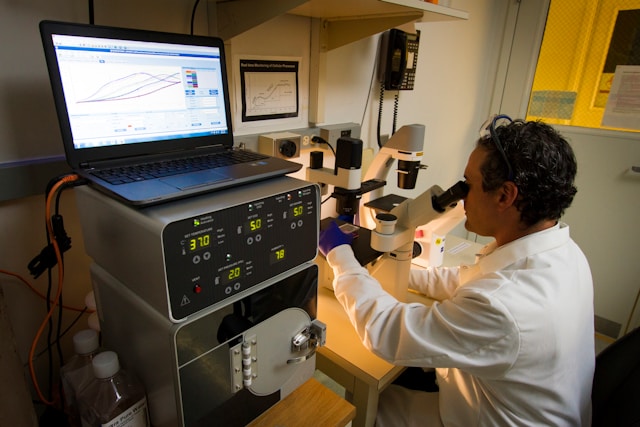Ever feel like science is just rocketing forward these days? Yeah, you’re definitely not wrong! It seems like every other day there’s a huge leap, from mapping out the entire human genome to running incredibly complex simulations of our climate. So, what’s really driving all this crazy momentum? Well, a massive part of the answer isn’t actually found in a physical lab anymore, but floating up there in the digital world: cloud computing.

Now, I know “cloud computing” might sound a bit like tech jargon, but honestly, it’s fundamentally changing the entire game for scientists, researchers, and innovators all over the globe. Think about it – no more clunky servers taking up precious lab space, or waiting days (sometimes weeks!) for complex calculations to finish. The cloud gives us access to computing power, collaboration tools, and analytical muscle like never before. It’s truly unlocking the future of scientific exploration. Let’s dive into how cloud computing is transforming scientific research and kicking off a whole new era of discovery.
Breaking Down Those Old Barriers: How the Cloud is Shaking Up Research
Okay, so traditionally, if you wanted to do cutting-edge scientific research, you needed massive, super expensive computer setups right there on-site. This created some pretty big hurdles, especially for smaller universities or researchers working in places with fewer resources. Cloud computing basically throws those barriers out the window by democratizing access to all that powerful tech.
Imagine needing the brainpower of thousands of computers to run a really complex simulation. Instead of needing the budget and space to build your own supercomputer center (which, let’s be real, most can’t do!), researchers can now tap into cloud infrastructure whenever they need it, paying only for what they use. This impact of cloud technology on global innovation is huge. It really levels the playing field, allowing brilliant minds, no matter where they are, to jump in and contribute to major scientific breakthroughs. We’re talking about virtual laboratories you can access from basically anywhere with an internet connection! Pretty cool, right?
Unleashing the Good Stuff: Why Science is Loving the Cloud
The advantages are seriously numerous, and they go way beyond just being able to access the tech. Here are some of the key benefits of cloud computing in scientific advancements:
- Scalability When You Need It: Research isn’t always predictable. One month you might just need a little bit of computing power, but the next, you could be running a massive simulation that needs enormous resources. The scalability of cloud technology for large-scale experiments means researchers can easily dial their resources up or down whenever they need to. You only pay for what you actually use, which makes a huge difference.
- Seriously Cost-Effective: Building and maintaining those high-performance computing (HPC) clusters? Incredibly expensive. The cost-effectiveness of cloud solutions in research gets rid of those massive upfront costs and replaces them with more predictable monthly expenses. This frees up precious funding for other vital parts of the research, like, you know, the actual science!
- Collaboration Made Easy: Let’s face it, science is rarely a one-person show. Cloud computing enhancing collaboration in science communities is a major win. Researchers spread across different universities, different countries, even different continents can easily access shared datasets, use the same tools, and see results stored centrally in the cloud using collaborative platforms. It just makes working together so much smoother.
- Access to the Latest and Greatest Tools: Cloud providers are always updating their tech. This means researchers get access to the newest hardware, the latest software (SaaS for research), and even sophisticated tools like machine learning in cloud environments without needing a huge IT team just to manage it all.
Powering Up Discovery: Cloud Solutions for Crunching Data
Modern science generates an absolutely mind-boggling amount of data. I mean, think about fields like genomics, particle physics, or climate science. Just dealing with this “Big Data” is often the biggest hurdle. And this is exactly where cloud solutions for effective data analysis in science really shine.

Cloud platforms offer powerful Big Data analytics services and the computational resources needed to chew through massive datasets efficiently. Researchers can use specialized cloud computing tools for real-time data processing in research, slashing analysis time from months or weeks down to days or even hours. This obviously speeds up the whole cycle of coming up with an idea, testing it, analyzing the results, and making that next big discovery. Data science techniques, often supercharged by cloud-based machine learning, can uncover patterns and insights that were previously just hidden in the noise.
Real-World Impact: Let’s Look at Some Examples
It helps to see how this actually plays out. Check out these case studies showcasing cloud computing in research:
- Genomics and Bioinformatics: Remember the 1000 Genomes Project? They heavily relied on cloud resources to store, process, and analyze huge amounts of genetic data. Crucially, this made the data accessible to researchers everywhere. Cloud platforms provide the sheer power needed for tricky tasks like sequence alignment and figuring out genetic variations.
- Climate Modeling: Simulating the Earth’s climate takes unbelievable amounts of computing power. Researchers use cloud HPC (High-Performance Computing) resources to run incredibly complex models. This helps them predict future climate scenarios and understand the potential impacts of climate change with much better accuracy.
- Particle Physics: Big experiments like the Large Hadron Collider (LHC) at CERN generate petabytes (that’s millions of gigabytes!) of data. Cloud infrastructure is absolutely vital for distributing all that data to physicists around the world so they can analyze it. It makes global collaboration on these fundamental physics questions possible.
So, What’s Next? Future Trends in Cloud Computing for Innovation
And guess what? The journey is far from over. We’re already seeing some really exciting future trends in cloud computing for innovation:
- Deeper AI and Machine Learning Integration: Expect even tighter integration of AI/ML services. This will help automate complex analyses and seriously speed up discovery in areas like developing new drugs or finding new materials.
- Serverless Computing: This lets researchers run code without even thinking about managing servers. It further cuts down on overhead and costs. Pretty neat!
- Hybrid and Multi-Cloud Approaches: We’ll see more researchers combining private clouds (their own infrastructure) with public clouds, or even using multiple different public cloud providers. This offers more flexibility and helps avoid getting locked into just one vendor.
- Quantum Computing (via the Cloud): Okay, this one is still pretty new, but cloud providers are starting to offer access to quantum computing resources. This could potentially revolutionize certain types of scientific problems that are currently impossible to solve.
Boosting Lab Life: Efficiency and Sustainability Too
Beyond just the heavy-duty computation, cloud services boosting efficiency in research labs are changing day-to-day work. Think shared experiment protocols, better data management systems, and maybe even controlling lab instruments remotely – all potentially run through the cloud. Plus, the role of cloud computing in sustainable scientific practices is becoming a bigger conversation. Those massive, highly optimized data centers run by the major cloud providers are often way more energy-efficient than having tons of smaller server rooms scattered across different labs. So, using the cloud could actually help reduce the overall carbon footprint of research. That’s a win-win!

Who Are the Big Players? Choosing Your Platform
There are definitely some major key players in cloud computing for scientific development you’ll hear about, like Amazon Web Services (AWS), Microsoft Azure, and Google Cloud Platform (GCP). Each of them offers specialized services designed for research tasks, HPC, AI/ML, and Big Data.
When researchers are doing a comparison of cloud platforms for scientific use cases, they need to weigh a few things:
- What specific services do they offer (e.g., special bioinformatics tools, simulation software)?
- How does the pricing work?
- What are the options for storing and moving data?
- What security measures and compliance certifications do they have (like HIPAA for health data)?
- How good is their customer support?
Honestly, choosing the right platform often boils down to the specific needs of that particular research project.
Let’s Talk Security (Because It’s Important!)

Naturally, when you’re dealing with sensitive research data, security is a huge concern. The security aspects of cloud computing in scientific data are definitely top of mind. You’ll find that reputable cloud providers invest heavily in security measures – stuff like encryption, strict access controls, and important compliance certifications. But, it’s kind of a shared responsibility. Researchers also need to make sure they’re following best practices for handling data and managing who gets access within that cloud environment.
The Cloud-Powered Future Isn’t Coming – It’s Already Here
So, it’s pretty clear that cloud computing isn’t just another tech tool; it’s a massive catalyst for digital transformation right across the scientific world. By giving researchers scalable resources, making global teamwork easier, enabling super-powerful data analysis, and making things more cost-effective, the cloud is fundamentally changing how research gets done.
From speeding up the discovery of new medicines to helping us understand our planet on a deeper level, the impact of cloud technology on global innovation is just undeniable. It empowers researchers to ask bigger questions, tackle way more complex problems, and ultimately, unlock the secrets of our universe faster than we ever thought possible.
What do you think? Have you seen cloud computing making waves in your own field or at your institution? It’s happening right now, and honestly, it’s pretty exciting to imagine what incredible discoveries are just around the corner, all powered by the seemingly limitless potential of the cloud.
